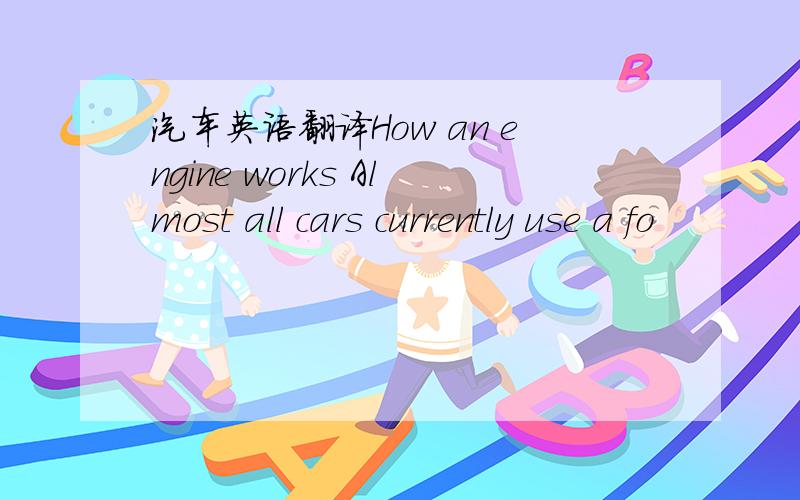汽车英语翻译How an engine works Almost all cars currently use a fo
来源:学生作业帮 编辑:大师作文网作业帮 分类:综合作业 时间:2024/11/16 13:42:41
汽车英语翻译
How an engine works
Almost all cars currently use a four-stroke combustion cycle to convert gasoline into motion. That is to say that the Intake stroke, Compression stroke, Power stroke and Exhaust stroke are one engine cycle. When the fourth stroke is completed, the cycle begins again. The four-stroke approach is also known as the Otto cycle, in honor of Nikolaus Otto, who invented it in 1867. The four-strokes are illustrated in Fig.1-8. They are:
Intake stroke
The first stroke is the intake stroke. As the piston starts down, the intake valve opens and the air-fuel mixture enter into the cylinder. When the piston reaches the bottom of the intake stroke, the intake valve closes, trapping the air-fuel mixture in the cylinder. During this stroke, the exhaust valve stays closed.
Compression stroke
The second stroke is the compression stroke. The piston moves up in the cylinder with both valves closed and compresses the trapped air-fuel mixture. When the piston reaches the top of the cylinder, the pressure rises.
Power stroke
The third stroke is the power stroke. Near the end of the compression stroke, the spark plug fires, igniting the compressed air-fuel mixture that produces a powerful explosion. The combustion process pushes the piston down the cylinder with great force tuning the crankshaft to provide the power to drive the car.
Exhaust stroke
The fourth stroke is the exhaust stroke. With the piston at the bottom of the cylinder, the exhaust valve opens, and the piston moves up again and forces the burned gases out of the cylinder. The piston travels up to the top of the cylinder pushing all the exhaust out before closing the exhaust valve in preparation for starting the four-stroke process over again.
How an engine works
Almost all cars currently use a four-stroke combustion cycle to convert gasoline into motion. That is to say that the Intake stroke, Compression stroke, Power stroke and Exhaust stroke are one engine cycle. When the fourth stroke is completed, the cycle begins again. The four-stroke approach is also known as the Otto cycle, in honor of Nikolaus Otto, who invented it in 1867. The four-strokes are illustrated in Fig.1-8. They are:
Intake stroke
The first stroke is the intake stroke. As the piston starts down, the intake valve opens and the air-fuel mixture enter into the cylinder. When the piston reaches the bottom of the intake stroke, the intake valve closes, trapping the air-fuel mixture in the cylinder. During this stroke, the exhaust valve stays closed.
Compression stroke
The second stroke is the compression stroke. The piston moves up in the cylinder with both valves closed and compresses the trapped air-fuel mixture. When the piston reaches the top of the cylinder, the pressure rises.
Power stroke
The third stroke is the power stroke. Near the end of the compression stroke, the spark plug fires, igniting the compressed air-fuel mixture that produces a powerful explosion. The combustion process pushes the piston down the cylinder with great force tuning the crankshaft to provide the power to drive the car.
Exhaust stroke
The fourth stroke is the exhaust stroke. With the piston at the bottom of the cylinder, the exhaust valve opens, and the piston moves up again and forces the burned gases out of the cylinder. The piston travels up to the top of the cylinder pushing all the exhaust out before closing the exhaust valve in preparation for starting the four-stroke process over again.

发动机如何工作?
几乎所有的汽车目前使用的是汽油四冲程燃烧循环方式。亦即,发动机完成吸气、压缩、作功、排气一个循环冲程为一个周期。当第四冲程完成,周期往复。四冲程方式也称为奥托循环,以纪念尼古拉奥托于1867年发明了它。四冲程的说明图8 。它们是:
吸气冲程
第一冲程是吸气冲程。由于活塞开始下降,进气阀开启和空气混合进入气缸。进气冲程当活塞到达底部,进气阀关闭,获得的空气燃料混合物在汽缸内。在此过程中,保持排气阀门关闭。
压缩冲程
第二冲程是压缩行程。活塞将气缸阀门关闭,压缩被捕获空气与燃料的混合物。当活塞到达气缸的顶部,压力上升。
做功冲程
第三冲程是做功冲程。当压缩冲程接近尾声,火花塞点火,引发压缩空气燃料混合物产生剧烈爆炸。燃烧过程向下推动活塞与气缸产生力量带动曲轴提供动力驱动汽车。
排气冲程
第四冲程是排气冲程。随着活塞到达气缸的底部,排气阀门开启时,活塞再次动作排除废气。活塞运动到气缸的顶部推动所有排气阀排气前关闭,准备再次四冲程。
几乎所有的汽车目前使用的是汽油四冲程燃烧循环方式。亦即,发动机完成吸气、压缩、作功、排气一个循环冲程为一个周期。当第四冲程完成,周期往复。四冲程方式也称为奥托循环,以纪念尼古拉奥托于1867年发明了它。四冲程的说明图8 。它们是:
吸气冲程
第一冲程是吸气冲程。由于活塞开始下降,进气阀开启和空气混合进入气缸。进气冲程当活塞到达底部,进气阀关闭,获得的空气燃料混合物在汽缸内。在此过程中,保持排气阀门关闭。
压缩冲程
第二冲程是压缩行程。活塞将气缸阀门关闭,压缩被捕获空气与燃料的混合物。当活塞到达气缸的顶部,压力上升。
做功冲程
第三冲程是做功冲程。当压缩冲程接近尾声,火花塞点火,引发压缩空气燃料混合物产生剧烈爆炸。燃烧过程向下推动活塞与气缸产生力量带动曲轴提供动力驱动汽车。
排气冲程
第四冲程是排气冲程。随着活塞到达气缸的底部,排气阀门开启时,活塞再次动作排除废气。活塞运动到气缸的顶部推动所有排气阀排气前关闭,准备再次四冲程。
英语翻译Currently,all Asian countries except Japan are playing a
英语翻译Smoking It is almost known to all that smoking is bad fo
英语翻译1.An automobile engine is an Internal combustion engine,
you engine how works know do the?(连词成句)
Research into how “iteration calculations” are currently use
英语翻译One third of people that shop online use a search engine
英语翻译knowing how to use a computer is an essential skill for
fire engine前用a还是an
英语翻译An internal combustion engine would not run for even a f
英语翻译Almost everybody likes to play.All over the world men an
英语翻译Property insurance on an “all risk” or “special risk” fo
How about my food?I___here for almost half an hour.A.have be